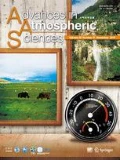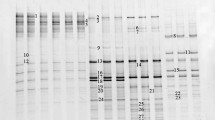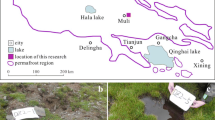Abstract
Wetland ecosystems are the most important natural methane (CH4) sources, whose fluxes periodically fluctuate. Methanogens (methane producers) and methanotrophs (methane consumers) are considered key factors affecting CH4 fluxes in wetlands. However, the symbiotic relationship between methanogens and methanotrophs remains unclear. To help close this research gap, we collected and analyzed samples from four soil depths in the Dajiuhu subalpine peatland in January, April, July, and October 2019 and acquired seasonal methane flux data from an eddy covariance (EC) system, and investigated relationships. A phylogenetic molecular ecological networks (pMENs) analysis was used to identify keystone species and the seasonal variations of the co-occurrence patterns of methanogenic and methanotrophic communities. The results indicate that the seasonal variations of the interactions between methanogenic and methanotrophic communities contributed to CH4 emissions in wetlands. The keystone species discerned by the network analysis also showed their importance in mediating CH4 fluxes. Methane (CH4) emissions in wetlands were lowest in spring; during this period, the most complex interactions between microbes were observed, with intense competition among methanogens while methanotrophs demonstrated better cooperation. Reverse patterns manifested themselves in summer when the highest CH4 flux was observed. Methanoregula formicica was negatively correlated with CH4 fluxes and occupied the largest ecological niches in the spring network. In contrast, both Methanocella arvoryzae and Methylocystaceae demonstrated positive correlations with CH4 fluxes and were better adapted to the microbial community in the summer. In addition, soil temperature and nitrogen were regarded as significant environmental factors to CH4 fluxes. This study was successful in explaining the seasonal patterns and microbial driving mechanisms of CH4 emissions in wetlands.
摘要
湿地生态系统是甲烷(CH4)最重要的天然来源,其排放呈现周期性变化规律。产甲烷菌和甲烷氧化菌是介导湿地CH4循环的重要功能菌群,然而,产甲烷菌和甲烷氧化菌群落的共现模式尚不明晰。于是,本文在2019年1月、4月、7月和10月中旬采集了神农架大九湖亚高山泥炭湿地4个深度土层的土壤样本,利用涡度相关系统收集了CH4通量数据。运用分子生态网络分析方法鉴定关键物种并分析大九湖湿地产甲烷菌和甲烷氧化菌群落共现模式的季节性变化规律。结果表明,产甲烷菌和甲烷氧化菌群落相互作用关系的季节性变化对湿地CH4排放具有显著影响,由分子网络识别出的关键物种具有调节CH4通量的重要作用。在春季,微生物间的相互作用关系最为复杂,产甲烷菌群落间呈现较为激烈的竞争关系而甲烷氧化菌群落间则呈现较好的合作关系,湿地CH4排放量最低;与之相反,夏季CH4排放量最高。Methanoregula formicica与CH4通量呈负相关关系且在春季网络中占据最大的生态位,而Methanocella arvoryzae和Methylocystaceae与CH4通量呈正相关关系且在夏季网络中占据较大的生态位。此外,土壤温度和土壤氮盐含量是影响CH4通量的重要环境因素。本研究为揭示湿地CH4排放季节性变化的微生物调控机理提供理论依据。
Similar content being viewed by others
References
Amaral, J. A., C. Archambault, S. R. Richards, and R. Knowles, 1995: Denitrification associated with groups I and II methanotrophs in a gradient enrichment system. FEMS Microbiology Ecology, 18, 289–298, https://doi.org/10.1111/j.1574-6941.1995.tb00185.x.
Barberán, A., S. T. Bates, E. O. Casamayor, and N. Fierer, 2012: Using network analysis to explore co-occurrence patterns in soil microbial communities. The ISME Journal, 6, 343–351, https://doi.org/10.1038/ismej.2011.119.
Bascompte, J., 2007: Networks in ecology. Basic and Applied Ecology, 8, 485–490, https://doi.org/10.1016/j.baae.2007.06.003.
Berry, D., and S. Widder, 2014: Deciphering microbial interactions and detecting keystone species with co-occurrence networks. Frontiers in Microbiology, 5, 219, https://doi.org/10.3389/fmicb.2014.00219.
Bodelier, P. L. E., and H. J. Laanbroek, 2004: Nitrogen as a regulatory factor of methane oxidation in soils and sediments. FEMS Microbiology Ecology, 47, 265–277, https://doi.org/10.1016/S0168-6496(03)00304-0.
Bodelier, P. L. E., P. Roslev, T. Henckel, and P. Frenzel, 2000: Stimulation by ammonium-based fertilizers of methane oxidation in soil around rice roots. Nature, 403, 421–424, https://doi.org/10.1038/35000193.
Chapman, E. J., H. Cadillo-Quiroz, D. L. Childers, M. R. Turetsky, and M. P. Waldrop, 2017: Soil microbial community composition is correlated to soil carbon processing along a boreal wetland formation gradient. European Journal of Soil Biology, 82, 17–26, https://doi.org/10.1016/j.ejsobi.2017.08.001.
Chen, Y., M. G. Dumont, N. P. McNamara, P. M. Chamberlain, L. Bodrossy, N. Stralis-Pavese, and J. C. Murrell, 2008: Diversity of the active methanotrophic community in acidic peatlands as assessed by mRNA and SIP-PLFA analyses. Environmental Microbiology, 10(2), 446–459, https://doi.org/10.1111/j.1462-2920.2007.01466.x.
Chowdhury, T. R., and R. P. Dick, 2013: Ecology of aerobic methanotrophs in controlling methane fluxes from wetlands. Applied Soil Ecology, 65, 8–22, https://doi.org/10.1016/j.apsoil.2012.12.014.
De Menezes, A. B., A. E. Richardson, and P. H. Thrall, 2017: Linking fungal—bacterial co-occurrences to soil ecosystem function. Current Opinion in Microbiology, 37, 135–141, https://doi.org/10.1016/j.mib.2017.06.006.
Drollinger, S., A. Maier, and S. Glatzel, 2019: Interannual and seasonal variability in carbon dioxide and methane fluxes of a pine peat bog in the Eastern Alps, Austria. Agricultural and Forest Meteorology, 275, 69–78, https://doi.org/10.1016/j.agrformet.2019.05.015.
Hao, Q. Q., F. H. Liu, Y. C. Zhang, O. M. Wang, and L. L. Xiao, 2020: Methylobacter accounts for strong aerobic methane oxidation in the Yellow River Delta with characteristics of a methane sink during the dry season. Science of the Total Environment, 704, 135383, https://doi.org/10.1016/j.scitotenv.2019.135383.
He, S. M., and Coauthors, 2015: Patterns in wetland microbial community composition and functional gene repertoire associated with methane emissions. mBio, 6(3), e00066–15, https://doi.org/10.1128/mBio.00066-15.
Horn, M. A., C. Matthies, K. Kusel, A. Schramm, and H. L. Drake, 2003: Hydrogenotrophic methanogenesis by moderately acid-tolerant methanogens of a methane-emitting acidic peat. Applied and Environmental Microbiology, 69(1), 74–83, https://doi.org/10.1128/AEM.69.1.74-83.2003.
Huang, R. L., Z. Y. Zhang, X. Xiao, N. Zhang, X. Y. Wang, Z. P. Yang, K. Q. Xu, and Y. T. Liang, 2019: Structural changes of soil organic matter and the linkage to rhizosphere bacterial communities with biochar amendment in manure fertilized soils. Science of the Total Environment, 692, 333–343, https://doi.org/10.1016/j.scitotenv.2019.07.262.
IPCC, 2013: Climate Change 2013: The Physical Science Basis: Working Group I Contribution to the Fifth Assessment Report of the Intergovernmental Panel on Climate Change. Cambridge University Press, Cambridge, United Kingdom and New York, NY, USA.
Juottonen, H., E.-S. Tuittila, S. Juutinen, H. Fritze, and K. Yrjälä, 2008: Seasonality of rDNA-and rRNA-derived archaeal communities and methanogenic potential in a boreal mire. The ISME Journal 2(11), 1157–1168, https://doi.org/10.1038/ismej.2008.66.
Kolton, M., A. Marks, R. M. Wilson, J. P. Chanton, and J. E. Kostka, 2019: Impact of Warming on greenhouse gas production and microbial diversity in anoxic peat from a Sphagnum-dominated bog (Grand Rapids, Minnesota, United States). Frontiers in Microbiology, 10, 870, https://doi.org/10.3389/fmicb.2019.00870.
Layeghifard, M., D. M. Hwang, and D. S. Guttman, 2017: Disentangling interactions in the microbiome: A network perspective. Trends in Microbiology, 25(3), 217–228, https://doi.org/10.1016/j.tim.2016.11.008.
Li, D., H. W. Ni, S. Jiao, Y. H. Lu, J. Z. Zhou, B. Sun, and Y. T. Liang, 2021: Coexistence patterns of soil methanogens are closely tied to methane generation and community assembly in rice paddies. Microbiome, 9(1), 20, https://doi.org/10.1186/s40168-020-00978-8.
Liebner, S., L. Ganzert, A. Kiss, S. Z. Yang, D. Wagner, and M. M. Svenning, 2015: Shifts in methanogenic community composition and methane fluxes along the degradation of discontinuous permafrost. Frontiers in Microbiology, 6, 356, https://doi.org/10.3389/fmicb.2015.00356.
Long, K. D., L. B. Flanagan, and T. B. Cai, 2010: Diurnal and seasonal variation in methane emissions in a northern Canadian peatland measured by eddy covariance. Global Change Biology, 16(9), 2420–2435, https://doi.org/10.1016/j.1365-2486.2009.02083.x.
Lu, L. H., S. X. Yin, X. Liu, W. M. Zhang, T. Y. Gu, Q. R. Shen, and H. Z. Qiu, 2013: Fungal networks in yield-invigorating and -debilitating soils induced by prolonged potato monoculture. Soil Biology and Biochemistry, 65, 186–194, https://doi.org/10.1016/j.soilbio.2013.05.025.
Lupatini, M., A. K. A. Suleiman, R. J. S. Jacques, Z. I. Antoniolli, A. De Siqueira Ferreira, E. E. Kuramae, and L. F. W. Roesch, 2014: Network topology reveals high connectance levels and few key microbial genera within soils. Frontiers in Environmental Science, 2, 10, https://doi.org/10.3389/fenvs.2014.00010.
Ma, B., and Coauthors, 2016: Geographic patterns of co-occurrence network topological features for soil microbiota at continental scale in eastern China. The ISME Journal, 10(8), 1891–1901, https://doi.org/10.1038/ismej.2015.261.
Ma, B., and Coauthors, 2020: Earth microbial co-occurrence network reveals interconnection pattern across microbiomes. Microbiome, 8(1), 82, https://doi.org/10.1186/s40168-020-00857-2.
Newman, M. E. J., 2006: Finding community structure in networks using the eigenvectors of matrices. Phys. Rev. E, 74(3), 036104, https://doi.org/10.1103/PHYSREVE.74.036104.
Olesen, J. M., J. Bascompte, Y. L. Dupont, and P. Jordano, 2007: The modularity of pollination networks. Proceedings of the National Academy of Sciences of the United States, 104(50), 19891–19896, https://doi.org/10.1073/pnas.0706375104.
Peltoniemi, K., and Coauthors, 2016: Responses of methanogenic and methanotrophic communities to warming in varying moisture regimes of two boreal fens. Soil Biology and Biochemistry, 97, 144–156, https://doi.org/10.1016/j.soilbio.2016.03.007.
Pypker, T. G., P. A. Moore, J. M. Waddington, J. A. Hribljan, and R. C. Chimner, 2013: Shifting environmental controls on CH4 fluxes in a sub-boreal peatland. Biogeosciences, 10(12), 7971–7981, https://doi.org/10.5194/bg-10-7971-2013.
Ramakrishnan, B., T. Lueders, P. F. Dunfield, R. Conrad, and M. W. Friedrich, 2001: Archaeal community structures in rice soils from different geographical regions before and after initiation of methane production. FEMS Microbiology Ecology, 37(2), 175–186, https://doi.org/10.1111/j.1574-6941.2001.tb00865.x.
Ren, J. S., C. C. Song, A. X. Hou, Y. Y. Song, X. Y. Zhu, and G. A. Cagle, 2018: Shifts in soil bacterial and archaeal communities during freeze-thaw cycles in a seasonal frozen marsh, Northeast China. Science of the Total Environment, 625, 782–791, https://doi.org/10.1016/j.scitotenv.2017.12.309.
Saunois, M., and Coauthors, 2020: The global methane budget 2000–2017. Earth System Science Data, 12(3), 1561–1623, https://doi.org/10.5194/essd-12-1561-2020.
Steele, J. A., and Coauthors, 2011: Marine bacterial, archaeal and protistan association networks reveal ecological linkages. The ISME Journal, 5(9), 1414–1425, https://doi.org/10.1038/ismej.2011.24.
Thauer, R. K., A. K. Kaster, H. Seedorf, W. Buckel, and R. Hedderich, 2008: Methanogenic archaea: Ecologically relevant differences in energy conservation. Nature Reviews Microbiology, 6(8), 579–591, https://doi.org/10.1038/nrmicro1931.
Toju, H., and Coauthors, 2018: Core microbiomes for sustainable agroecosystems. Nature Plants, 4(5), 247–257, https://doi.org/10.1038/s41477-018-0139-4.
Wagner, D., 2017: Effect of varying soil water potentials on methanogenesis in aerated marshland soils. Scientific Reports, 7, 14706, https://doi.org/10.1038/s41598-017-14980-y.
Wang, X. H., M. H. Zhu, N. K. Li, S. Du, J. D. Yang, and Y. Li, 2018: Effects of CeO2 nanoparticles on bacterial community and molecular ecological network in activated sludge system. Environmental Pollution, 238, 516–523, https://doi.org/10.1016/j.envpol.2018.03.034.
WMO/GAW, 2020: WMO greenhouse gas bulletin: The state of greenhouse gases in the atmosphere based on global observations through 2019, https://library.wmo.int/doc_num.php? explnum_id=10437.
Xie, F., A. Z. Ma, H. C. Zhou, Y. Liang, J. Yin, K. Ma, X. L. Zhuang, and G. Q. Zhuang, 2020: Niche differentiation of denitrifying anaerobic methane oxidizing bacteria and archaea leads to effective methane filtration in a Tibetan alpine wetland. Environment International, 140, 105764, https://doi.org/10.1016/j.envint.2020.105764.
Yavitt, J. B., E. Yashiro, H. Cadillo-Quiroz, and S. H. Zinder, 2012: Methanogen diversity and community composition in peatlands of the central to northern Appalachian Mountain region, North America. Biogeochemistry, 109, 117–131, https://doi.org/10.1007/s10533-011-9644-5.
Zhang, J., S. Jiao, and Y. H. Lu, 2018: Biogeographic distribution of bacterial, archaeal and methanogenic communities and their associations with methanogenic capacity in Chinese wetlands. Science of the Total Environment, 622–623, 664–675, https://doi.org/10.1016/j.scitotenv.2017.11.279.
Zhang, Q., R. Sun, G. Q. Jiang, Z. W. Xu, and S. M. Liu, 2016: Carbon and energy flux from a Phragmites australis wetland in Zhangye oasis-desert area, China. Agricultural and Forest Meteorology, 230–231, 45–57, https://doi.org/10.1016/j.agrformet.2016.02.019.
Zhang, Q. T., and Coauthors, 2019: High variations of methanogenic microorganisms drive full-scale anaerobic digestion process. Environment International, 126, 543–551, https://doi.org/10.1016/j.envint.2019.03.005.
Zhao, Y. X., J. Q. Wang, Y. Liu, P. Zheng, and B. L. Hu, 2021: Microbial interaction promotes desulfurization efficiency under high pH condition. Environ. Res., 200, 111423, https://doi.org/10.1016/j.envres.2021.111423.
Zhou, J. Z., Y. Deng, F. Luo, Z. L. He, and Y. F. Yang, 2011: Phylogenetic molecular ecological network of soil microbial communities in response to elevated CO2. mBio, 2(4), e00122–11, https://doi.org/10.1128/mBio.00122-11.
Zou, L. H., W. J. Pei, T. Li, Z. Y. He, and Y. Cheung, 2007: Topological fractal networks introduced by mixed degree distribution. Physica A: Statistical Mechanics and its Applications, 380, 592–600, https://doi.org/10.1016/j.physa.2007.02.060.
Acknowledgements
This work was supported by the National Science Foundation of China (Grant No. 31971490). We thank the Institute of Shennongjia National Park Administration Bureau for data collecting assistance.
Author information
Authors and Affiliations
Corresponding author
Additional information
Article Highlights
• The EC method was used to observe the dynamics of CH4 fluxes, which were highest in summer and lowest in spring.
• The seasonal variations of interactions between methanogens and methanotrophs contributed to CH4 emissions in wetlands.
• The keystone species discerned by network analysis showed their importance in mediating CH4 fluxes.
• Soil temperature and nitrogen were regarded as important environmental factors to CH4 fluxes.
This paper is a contribution to the special issue on Carbon Neutrality: Important Roles of Renewable Energies, Carbon Sinks, NETs and non-CO2 GHGs.
Electronic Supplementary Material
376_2021_1255_MOESM1_ESM.pdf
The Synergism between Methanogens and Methanotrophs and the Nature of their Contributions to the Seasonal Variation of Methane Fluxes in a Wetland: The Case of Dajiuhu Subalpine Peatland
Rights and permissions
About this article
Cite this article
Wang, L., Ge, J., Feng, L. et al. The Synergism between Methanogens and Methanotrophs and the Nature of their Contributions to the Seasonal Variation of Methane Fluxes in a Wetland: The Case of Dajiuhu Subalpine Peatland. Adv. Atmos. Sci. 39, 1375–1385 (2022). https://doi.org/10.1007/s00376-021-1255-z
Received:
Revised:
Accepted:
Published:
Issue Date:
DOI: https://doi.org/10.1007/s00376-021-1255-z




